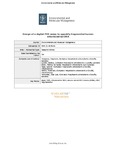Mostrar o rexistro simple do ítem
Design of a digital-PCR assay to quantify fragmented human mitochondrial DNA
| dc.contributor.author | Mosquera, Alejandro | |
| dc.contributor.author | Guillén, Rebeca | |
| dc.contributor.author | Otero, Fátima | |
| dc.contributor.author | Rego-Pérez, Ignacio | |
| dc.contributor.author | Blanco García, Francisco J | |
| dc.contributor.author | Fernández, José Luis | |
| dc.date.accessioned | 2021-12-02T10:29:43Z | |
| dc.date.issued | 2021-06-11 | |
| dc.identifier.citation | Mosquera A, Guillén R, Otero F, Rego-Pérez I, Blanco FJ, Fernández JL. Design of a digital-PCR assay to quantify fragmented human mitochondrial DNA. Environ Mol Mutagen. 2021;62(6):364-373 | es_ES |
| dc.identifier.issn | 0893-6692 | |
| dc.identifier.uri | http://hdl.handle.net/2183/29052 | |
| dc.description.abstract | [Abstract] Digital PCR (dPCR) has been adapted to quantify the proportion of mitochondrial DNA (mtDNA) molecules without and with double-strand DNA breaks (DSBs). This is based on a break-apart approach of two differentially labeled target sequences distantly located in the circular DNA molecule. When the two targets amplify in separated reaction partitions, the original mtDNA molecule should be fragmented by two DSBs at least, each in a different segment between targets. When both targets amplify in the same partition, it must correspond to a circular or linear mtDNA molecule. These two possibilities may be distinguished through a restriction endonuclease (RE) induced unique DSB within a DNA segment between the targets. After RE-digestion, separation of both target signals in different partitions must indicate the presence of a previous linear mtDNA molecule. Otherwise, joint amplification in the same partition would correspond to an initial circular mtDNA that has been linearized by the endonuclease. The procedure was validated by assaying different proportions of mtDNA fragmented by in vitro digestion with REs, evidencing a perfect accordance between the expected theoretical values and dPCR quantification. Samples from peripheral blood cells, cellular and extracellular DNA from the U2OS cell line, as well as cells incubated with ethidium bromide to induce mtDNA depletion, were evaluated. The technique may be of interest to complement the studies of mtDNA in relation to aging and human disease, as well as to assess possible adverse effects of certain drugs that could be related to affectation of mtDNA. | es_ES |
| dc.description.sponsorship | Instituto de Salud Carlos III; PIE16/00054 | es_ES |
| dc.language.iso | eng | es_ES |
| dc.publisher | Wiley | es_ES |
| dc.relation.uri | https://doi.org/10.1002/em.22449 | es_ES |
| dc.rights | This is the peer reviewed version of the following article, which has been published in final form at Wiley Online Library. This article may be used for non-commercial purposes in accordance with Wiley Terms and Conditions for Use of Self-Archived Versions. This article may not be enhanced, enriched or otherwise transformed into a derivative work, without express permission from Wiley or by statutory rights under applicable legislation. Copyright notices must not be removed, obscured or modified. The article must be linked to Wiley’s version of record on Wiley Online Library and any embedding, framing or otherwise making available the article or pages thereof by third parties from platforms, services and websites other than Wiley Online Library must be prohibited. | es_ES |
| dc.subject | DNA fragmentation | es_ES |
| dc.subject | Digital PCR | es_ES |
| dc.subject | Double-strand DNA breaks (DSBs) | es_ES |
| dc.subject | Mitochondrial DNA | es_ES |
| dc.title | Design of a digital-PCR assay to quantify fragmented human mitochondrial DNA | es_ES |
| dc.type | info:eu-repo/semantics/article | es_ES |
| dc.rights.access | info:eu-repo/semantics/embargoedAccess | es_ES |
| dc.date.embargoEndDate | 2022-06-11 | es_ES |
| dc.date.embargoLift | 2022-06-11 | |
| UDC.journalTitle | Environmental and Molecular Mutagenesis | es_ES |
| UDC.volume | 62 | es_ES |
| UDC.issue | 6 | es_ES |
| UDC.startPage | 364 | es_ES |
| UDC.endPage | 373 | es_ES |
Ficheiros no ítem
Este ítem aparece na(s) seguinte(s) colección(s)
-
INIBIC- REUMA - Artigos [184]






